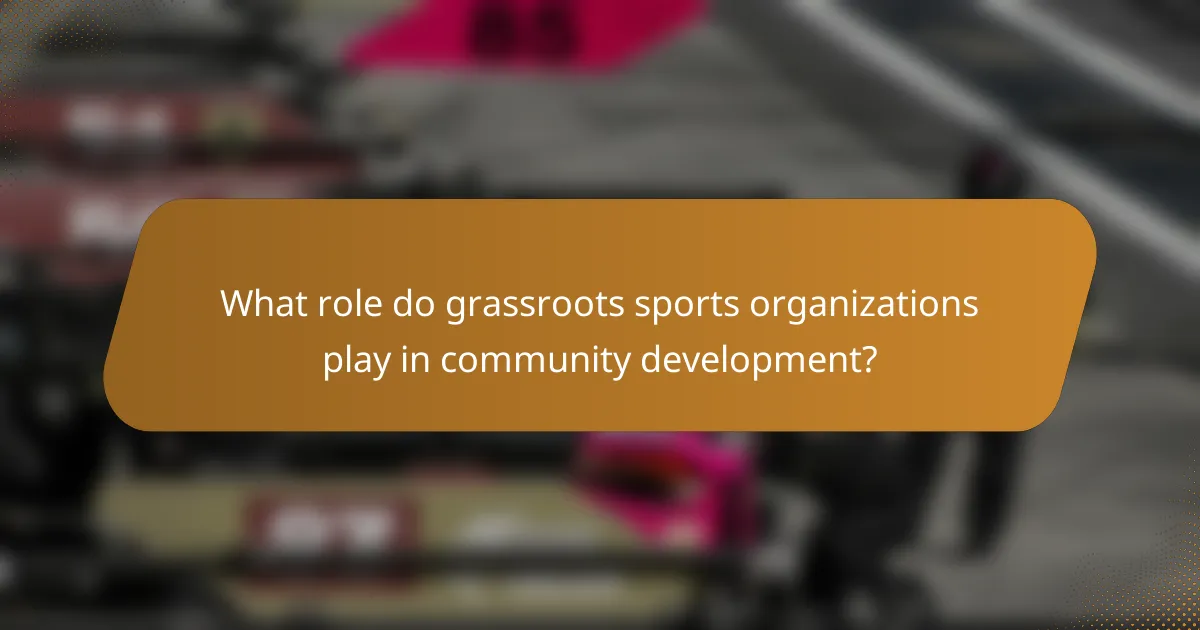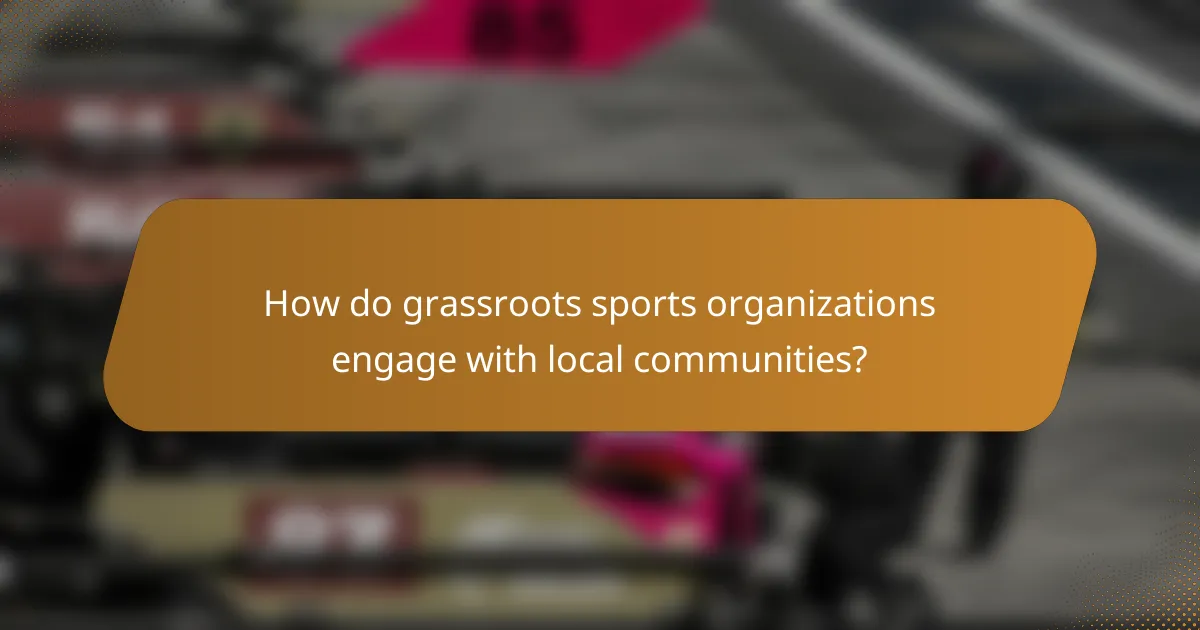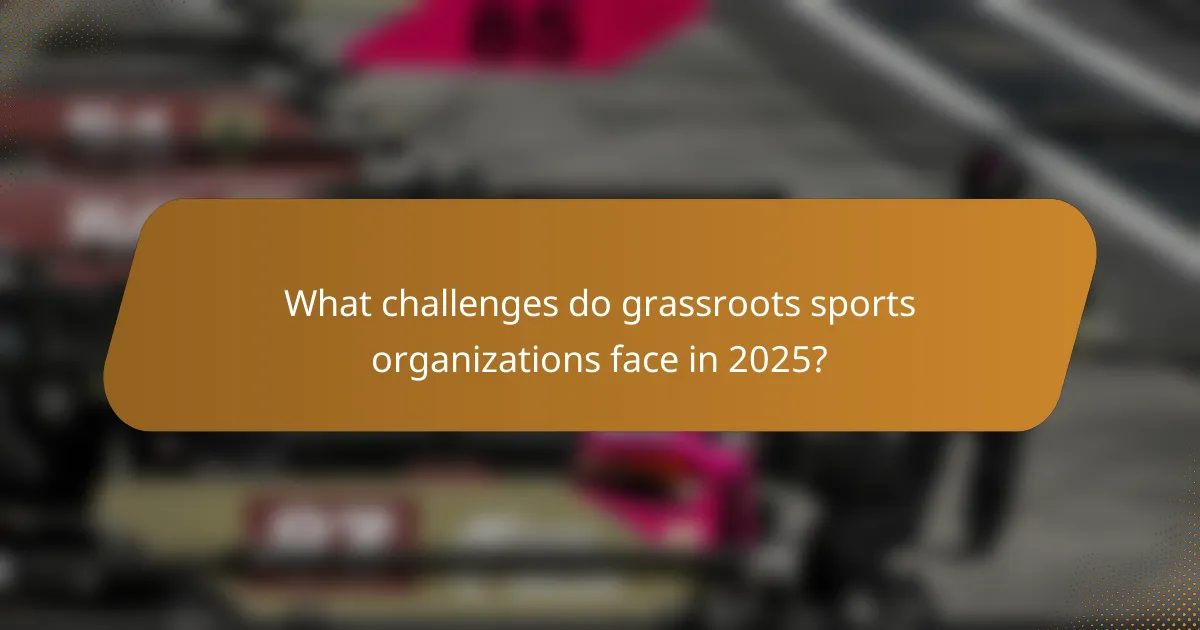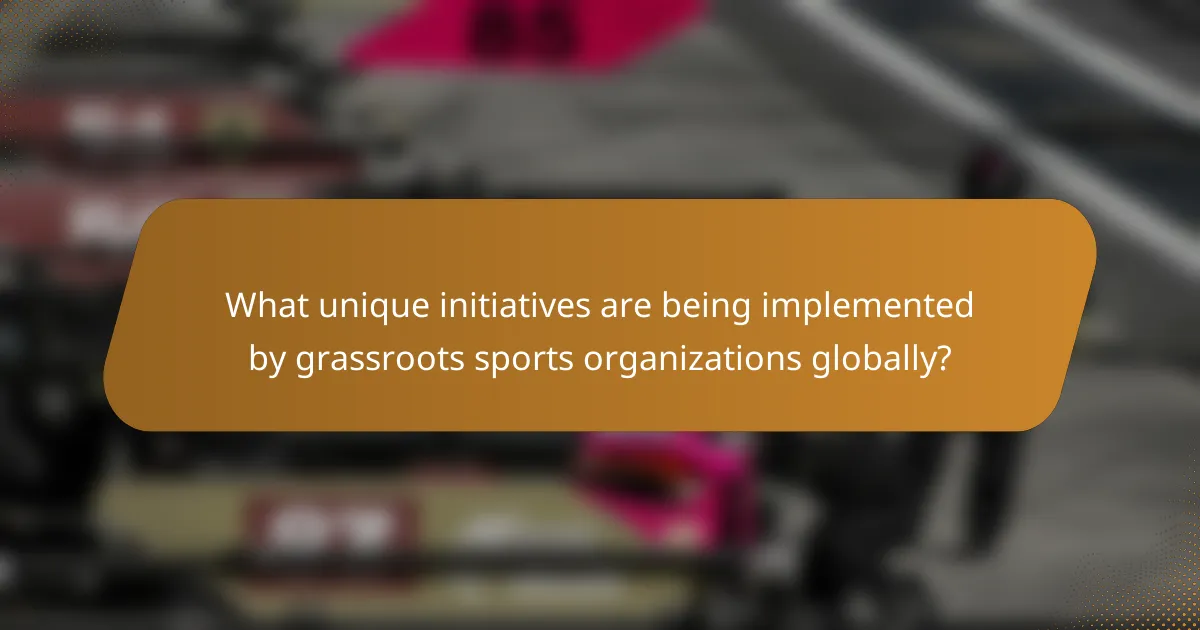Grassroots sports organizations significantly enhance community well-being by promoting health, fostering youth engagement, and creating inclusive environments. They provide essential benefits such as skill development and social interaction while stimulating local economies through events and volunteerism. These organizations face challenges like funding shortages and competition from professional leagues, yet they implement unique initiatives to engage diverse demographics. Effective measurement of their impact includes tracking participation metrics and assessing social outcomes.

What role do grassroots sports organizations play in community development?
Grassroots sports organizations play a vital role in community development by fostering social cohesion, promoting health, and providing youth engagement. They create inclusive environments where individuals of all ages can participate in sports, enhancing community ties.
These organizations contribute to physical and mental well-being by encouraging active lifestyles. Participation in sports can reduce health issues, as studies indicate that active individuals experience lower rates of chronic diseases.
Moreover, grassroots sports organizations often serve as platforms for youth development, teaching essential life skills such as teamwork, leadership, and discipline. This engagement can lead to improved educational outcomes and reduced delinquency rates.
Finally, by organizing events and activities, these organizations stimulate local economies and create opportunities for volunteerism, strengthening community bonds.
How do these organizations foster social inclusion and cohesion?
Grassroots sports organizations foster social inclusion and cohesion by creating accessible environments for diverse community members. They promote teamwork, build social networks, and encourage participation across various demographics. These organizations often provide programs tailored to underrepresented groups, enhancing their sense of belonging. Additionally, they host community events that unite individuals through shared interests, further strengthening social ties.
What impact do they have on youth engagement and development?
Grassroots sports organizations significantly enhance youth engagement and development by fostering teamwork, discipline, and leadership skills. These organizations provide structured environments that encourage physical activity and social interaction. Participation in grassroots sports can lead to improved self-esteem and mental health among youth. Additionally, these programs often offer mentorship opportunities, connecting young athletes with positive role models in their communities.

What are the key benefits of grassroots sports organizations for participants?
Grassroots sports organizations provide essential benefits for participants, including skill development, social interaction, and community building. Participants gain access to physical activity, which promotes health and well-being. These organizations often foster teamwork and leadership skills, enhancing personal growth. Additionally, they create inclusive environments that welcome diverse participants, encouraging lifelong engagement in sports.
Which health benefits are associated with grassroots sports participation?
Grassroots sports participation offers numerous health benefits, including improved physical fitness, mental well-being, and social connections. Engaging in these activities promotes cardiovascular health, strengthens muscles, and enhances overall endurance. Additionally, participation reduces stress and anxiety levels, fostering a sense of community and belonging. Regular involvement can lead to healthier lifestyle choices, contributing to long-term wellness.
How do grassroots organizations enhance life skills among participants?
Grassroots organizations enhance life skills among participants by fostering teamwork, communication, and leadership abilities. These organizations provide a supportive environment where individuals engage in collaborative activities, promoting personal growth.
Participants learn to set goals, manage time, and overcome challenges through structured programs. For example, team sports teach conflict resolution and social interaction. As a result, individuals gain confidence and resilience, essential traits for personal and professional success.
Moreover, grassroots organizations often tailor their programs to meet community needs, ensuring relevance and impact. This localized approach allows for unique skill development based on the specific demographics they serve.
Overall, grassroots sports organizations play a crucial role in enhancing life skills, empowering individuals, and strengthening community bonds.

How do grassroots sports organizations engage with local communities?
Grassroots sports organizations engage with local communities by fostering participation, promoting inclusivity, and enhancing community spirit. They organize events, provide training opportunities, and collaborate with schools and local businesses. These organizations often tailor their programs to meet community needs, which strengthens local ties. Their unique attribute is the ability to create sustainable engagement through volunteerism and local support, leading to improved health and social cohesion.
What strategies are effective for community outreach and involvement?
Effective strategies for community outreach and involvement include building partnerships, engaging local leaders, and utilizing social media. Grassroots sports organizations can foster relationships with schools and community centers to enhance participation. Hosting events and workshops encourages direct interaction and feedback from community members. Additionally, leveraging social media platforms can amplify outreach efforts, providing updates and creating a sense of community. These strategies not only increase visibility but also strengthen community ties, ensuring sustainable engagement.
How do partnerships with local businesses and schools enhance engagement?
Partnerships with local businesses and schools significantly enhance engagement in grassroots sports organizations by fostering community connections. These collaborations provide resources, increase visibility, and create opportunities for shared events. For instance, local businesses can sponsor teams, while schools can host sports activities, promoting participation. As a result, these partnerships strengthen community ties and encourage youth involvement in sports.

Which funding models support grassroots sports organizations?
Various funding models support grassroots sports organizations, including government grants, corporate sponsorships, community fundraising, and membership fees. These models enhance accessibility and sustainability for local sports initiatives.
Government grants provide essential financial backing, often aimed at promoting health and community engagement. Corporate sponsorships offer financial resources in exchange for brand visibility, fostering partnerships that benefit both parties. Community fundraising engages local residents, creating a sense of ownership and support for sports initiatives. Membership fees generate consistent revenue while encouraging participation and commitment from community members.
These funding models collectively strengthen grassroots sports organizations, enabling them to thrive and positively impact their communities.
What role do grants and sponsorships play in sustaining these organizations?
Grants and sponsorships are crucial for grassroots sports organizations, providing essential funding and resources. These financial supports enable organizations to maintain operations, develop programs, and engage with communities effectively. Grants often come from government bodies or foundations, while sponsorships are typically provided by businesses seeking visibility and community goodwill. The unique attribute of these funding sources lies in their ability to foster local talent and promote inclusivity in sports. As a result, organizations can offer more opportunities for participation, enhancing community engagement and overall impact.
How can fundraising events be optimized for greater impact?
Fundraising events can be optimized by focusing on community engagement, strategic partnerships, and targeted marketing. Grassroots sports organizations can leverage local networks to enhance participation and support. Engaging the community fosters a sense of ownership and increases attendance. Collaborating with local businesses can provide resources and sponsorships, amplifying the event’s reach. Utilizing social media for targeted campaigns can effectively attract participants and donors. Additionally, measuring event success through metrics like funds raised and community involvement can guide future improvements.

What challenges do grassroots sports organizations face in 2025?
Grassroots sports organizations face significant challenges in 2025, including funding shortages, increasing competition from professional leagues, and difficulties in community engagement. These organizations often struggle to secure sponsorships and grants, which limits their operational capacity. As professional sports gain more attention, grassroots initiatives find it harder to attract participants and volunteers. Additionally, fostering community involvement requires innovative strategies to connect with diverse demographics.
How can organizations adapt to changing community needs and demographics?
Organizations can adapt to changing community needs by actively engaging with grassroots sports organizations. These entities foster community involvement and provide tailored programs that reflect local demographics.
Grassroots sports organizations create inclusive environments that encourage participation across age groups and skill levels. They often hold events that address specific community interests, enhancing social cohesion. By collaborating with local stakeholders, these organizations can gather insights on community preferences and needs.
Furthermore, they can implement feedback mechanisms to continually assess and adapt their offerings. This responsiveness ensures that programs remain relevant and beneficial, fostering long-term community engagement.
In summary, grassroots sports organizations play a vital role in aligning sports initiatives with evolving community demographics and needs.
What are common pitfalls to avoid in grassroots sports management?
Common pitfalls in grassroots sports management include poor communication, lack of clear goals, insufficient funding, and neglecting community engagement. Failing to establish effective communication can lead to misunderstandings among stakeholders. Setting unclear goals can hinder progress and motivation. Inadequate funding limits resources for programs and facilities. Lastly, ignoring community involvement can reduce support and participation, ultimately impacting the organization’s success.
How can technology be leveraged to overcome operational challenges?
Technology can enhance grassroots sports organizations by improving communication, streamlining operations, and increasing community engagement. Tools like social media platforms facilitate outreach and connection with local communities. Data analytics can optimize resource allocation and track participant engagement. Mobile apps can simplify event registration and enhance user experience. Additionally, online fundraising platforms expand financial support opportunities. These technological advancements collectively help organizations address operational challenges effectively.

What unique initiatives are being implemented by grassroots sports organizations globally?
Grassroots sports organizations globally implement unique initiatives that enhance community engagement and promote inclusivity. These initiatives often focus on providing accessible sports programs, mentorship opportunities, and health education. For example, organizations may offer free training sessions to underprivileged youth, fostering skill development and teamwork. Additionally, some groups prioritize environmental sustainability by organizing events that clean local parks while promoting physical activity. Another unique initiative includes partnerships with schools to integrate sports into the curriculum, encouraging lifelong fitness habits. These efforts not only improve athletic participation but also strengthen community bonds.
How are organizations addressing environmental sustainability in sports?
Grassroots sports organizations are actively promoting environmental sustainability through community initiatives and education. They implement recycling programs, reduce waste, and encourage eco-friendly practices among participants. These organizations often collaborate with local governments to enhance green spaces, making sports venues more sustainable. They engage communities by hosting events focused on environmental awareness, fostering a culture of sustainability in sports.
What innovative programs are emerging to support underrepresented groups?
Grassroots sports organizations are emerging as vital programs to support underrepresented groups by providing inclusive opportunities and resources. These organizations offer tailored programs that promote participation, skill development, and community engagement. They often focus on addressing barriers such as access to facilities, funding, and coaching, ensuring that diverse populations can participate in sports.
Additionally, grassroots initiatives foster a sense of belonging and empowerment, creating networks that connect individuals from similar backgrounds. For instance, programs specifically designed for girls or minority communities help build confidence and leadership skills. As a result, these organizations not only enhance athletic participation but also contribute to social change and community cohesion.

How can grassroots sports organizations measure their impact effectively?
Grassroots sports organizations can measure their impact effectively through community feedback, participation metrics, and social outcomes. Utilizing surveys and interviews provides qualitative insights, while tracking participation rates and program growth offers quantitative data. Additionally, assessing social benefits, such as improved health and community cohesion, highlights the broader influence of these organizations. Combining these methods creates a comprehensive evaluation framework that captures both immediate and long-term effects.
What metrics are most useful for evaluating community engagement?
The most useful metrics for evaluating community engagement in grassroots sports organizations include participation rates, volunteer involvement, event attendance, social media interactions, and feedback surveys. These metrics provide insights into community interest and support.
| Metric | Description |
|————————|——————————————-|
| Participation Rates | Measures the number of active members |
| Volunteer Involvement | Tracks the number of volunteers engaged |
| Event Attendance | Counts attendees at organized events |
| Social Media Interactions| Analyzes engagement across platforms |
| Feedback Surveys | Gathers community opinions and suggestions |
How can success stories be used to attract more participants and support?
Success stories can significantly attract more participants and support for grassroots sports organizations. They showcase the positive impact on individuals and communities, inspiring others to join. Highlighting personal transformations and community benefits builds trust and relatability. Engaging narratives can leverage social media, reaching wider audiences and encouraging participation. By sharing diverse success stories, organizations can emphasize unique attributes, such as inclusivity and empowerment, fostering a sense of belonging.
What best practices can organizations adopt for continuous improvement?
Organizations can adopt several best practices for continuous improvement. First, they should foster a culture of feedback, encouraging open communication among members. Second, implementing regular training sessions enhances skills and knowledge. Third, utilizing data analytics helps identify areas needing improvement. Fourth, setting clear, measurable goals ensures accountability and progress tracking. Lastly, engaging with the community strengthens relationships and promotes collaborative growth.
